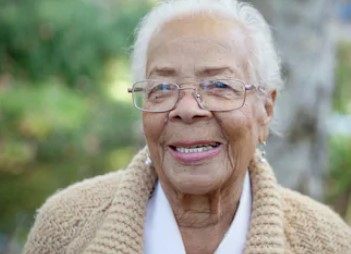Mary Jackson, aged 90, grew up in Culpepper, VA, a small, rural community located 80 miles west of Washington, DC where job prospects for young African American women were limited to domestic work and babysitting for 50 cents an hour.

“I wanted to get away from that,” she says. “There was a lot of industry coming to that part of Virginia, but we learned that those companies had signed an agreement not to hire black people for no other position than janitorial work. I wanted to leave as soon as I could.”
Mary moved to Boston, MA in 1954 to live with a cousin. “She was making good money working in a garment factory and she kept telling me to come to Boston to live with her,” says Mary. “She was like a mother to me.” Mary soon got a job working at the same garment factory as her cousin, and that’s where she would stay for the next couple years.
In 1963, Mary married Sterling Jackson, a truck driver and occasional fish monger. She was now working in an electronics factory making even better money. “I got a job as a solderer,” she says. “You may never have noticed, but there are large cables that run alongside railroad tracks. These are thick cables, about two inches in circumference. There are connectors on each end for the electrical wires to connect to and my job was to solder the connectors onto the cables. I also soldered the tubes that went into television sets.”
Seventeen years later, the couple bought their first home in Dorchester, MA, a 2.5-unit property built in 1898. “I prayed to God that we could make the monthly payments,” says Mary.
For three years everything was fine. But at age 51, Sterling suffered a debilitating stroke and was on disability until his death in 2002.
After Sterling’s death, Mary continued to pay the mortgage but, over time, it became increasingly more difficult. “Then I heard about reverse mortgages,” says Mary, “where the lender pays you instead of you paying the lender.”
She consulted her friends and a local television celebrity who provided retirement planning advice. They all discouraged her from pursuing a reverse mortgage. “They all said if it sounds too good to be true, then it must be. I even spoke to some people who had reverse mortgages and lost their homes,” adds Mary.
“I found out the reason why they lost their homes was because they got a lump sum of money and used the proceeds to buy their children cars and other gifts. When they ran out of money, they could no longer afford to pay for the upkeep on their homes or pay their taxes and insurance,” she says. “They weren’t doing what they were supposed to do.”
She finally had a conversation with her brother, and he convinced her it was worth getting a reverse mortgage. Mary closed on a reverse mortgage in December 2008 and was able to pay off her mortgage and eliminate her monthly mortgage payment.
Over the next decade, Mary’s home increased in value from $280,000 to $690,000. She thought about refinancing her reverse mortgage but held off. Mary assumed that to refinance her reverse mortgage meant that she would have to sell her home to pay off the current loan. The last thing she wanted to do was sell the home that she and Sterling had worked so hard to keep.
One day, she read an article in a local newspaper written by George Downey, a Certified Reverse Mortgage Specialist and owner of Harbor Mortgage Solutions in Braintree, MA. “When I called up Mr. Downey, I found that he was an authority on reverse mortgages. I learned that to refinance, I didn’t have to move out of the house. It was a great relief to me.”
Property taxes are very high in the Boston area, so Mary decided to use the new reverse mortgage to help pay her taxes and alleviate that worry.
Mary refinanced in 2019 and asked Downey to establish a voluntary Life Expectancy Set Aside that would pay her future property taxes and homeowners’ insurance for the next several years.
“A reverse mortgage may not be right for everyone, but it was the right fit for me,” adds Mary.